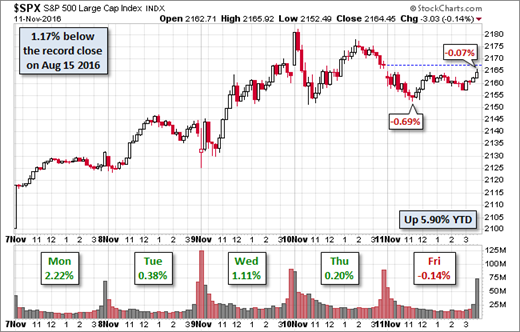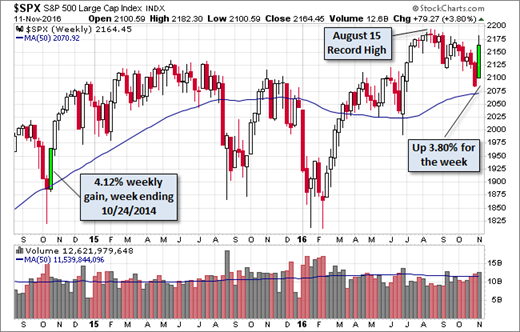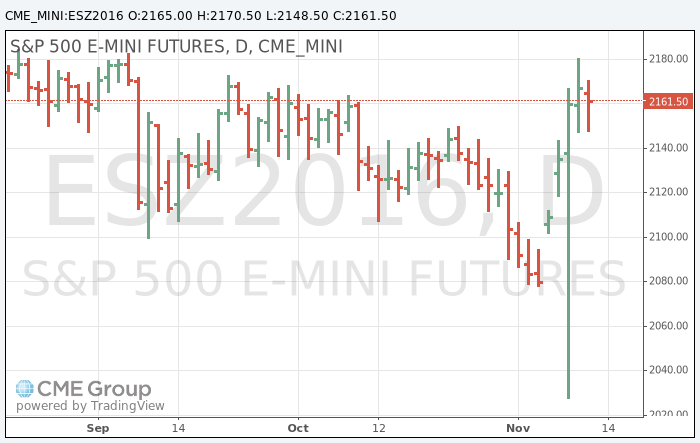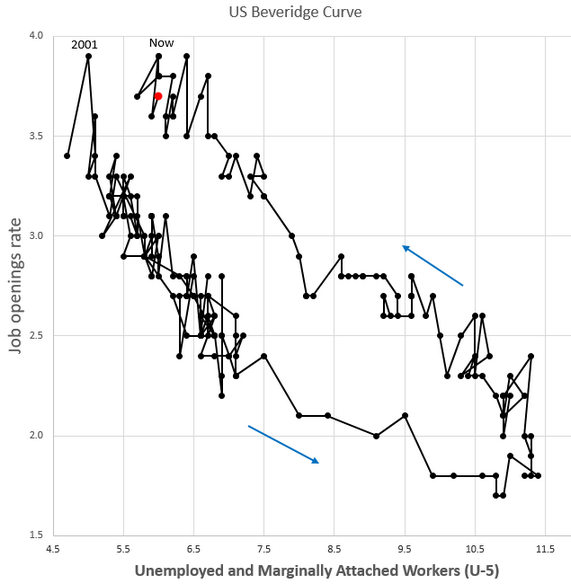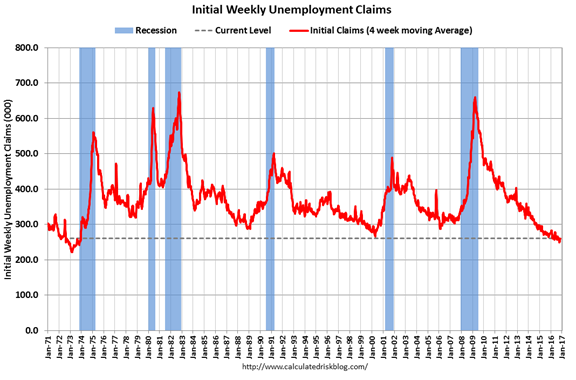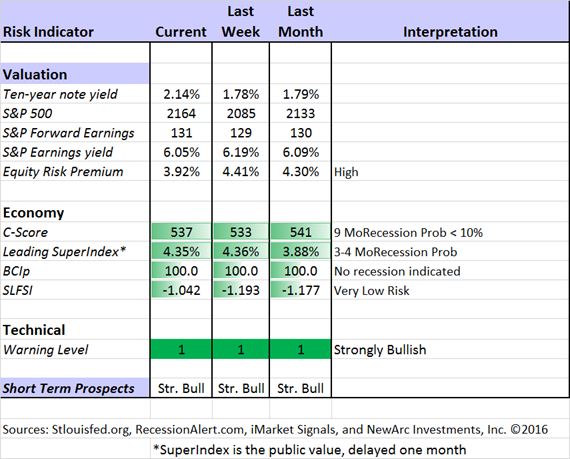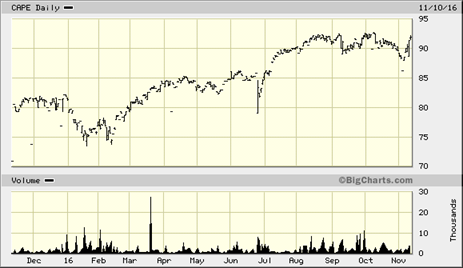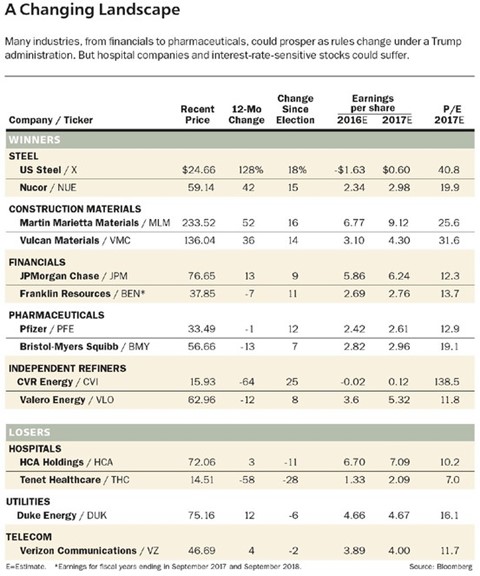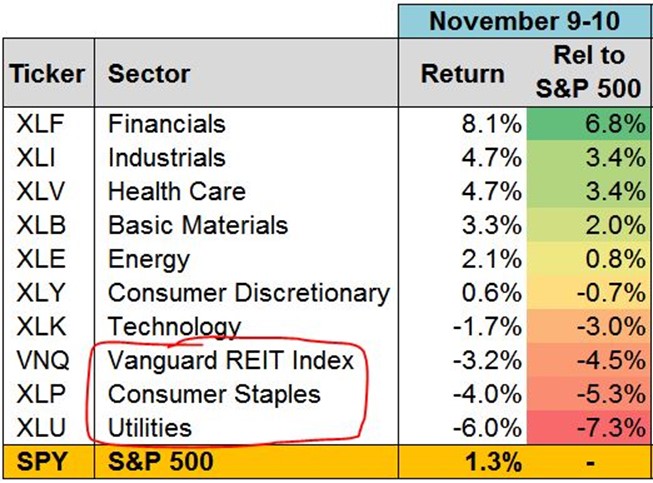There is some important data on the schedule for this week, along with earnings and the expected doses of FedSpeak. None of that will attract much attention. Instead expect “all Trump, all the time”. The slant in financial media will be the implications for investors. As we get news of the leadership transition, I expect the punditry to be asking:
Do investment portfolios need a transition?
Last Week
Last week’s economic news was all good, but less important than the election.
Theme Recap
In my last WTWA, I predicted a focus on the election and the chances for greater economic and financial clarity. The election expectation was obvious, and there was indeed a focus on the implications for investors. That said, I embraced the consensus expectations which proved to be dramatically incorrect. I did correctly note that the crystal ball would remain cloudy, but that proved to be quite an understatement.
The Story in One Chart
I always start my personal review of the week by looking at this great chart of the S&P 500 from Doug Short. He captures the post-election rally as well as the Friday fizzling.
Doug has a special knack for pulling together all the relevant information. His charts save more than a thousand words! Read his entire post where he adds analysis grounded in data and several more charts providing long-term perspective. Here is one additional example.
The big story of the trading week does not show up in the stock market data. As the Trump victory became apparent, overnight trading in stock futures showed a massive decline. This chart shows the selling and the morning rebound.
The News
Each week I break down events into good and bad. Often there is an “ugly” and on rare occasion something very positive. My working definition of “good” has two components. The news must be market friendly and better than expectations. I avoid using my personal preferences in evaluating news – and you should, too!
This week’s news was quite good. If I missed something for the “bad” list, please feel free to suggest it in the comments.
The Good
- Election uncertainty ended. This was a known, market-friendly event, although the amount of the reaction was a surprise.
- Framing lumber demand drives higher prices. Those who prefer market data to other source should take note of the data from Calculated Risk.
- Earnings reports continue strength on all measures. Earnings growth, results versus expectations, sales versus expectations, and outlook are all solid (FactSet). It is not getting much attention, but the “earnings recession” is over. Brian Gilmartin provided the first alert on this dramatic shift, and now points to a possible expansion in multiples. Ed Yardeni shows the impact via changed expectations.
- Michigan sentiment showed strength with a reading of 91.6, solidly beating the prior month and expectations. The survey was before the election.
- JOLTS remained positive. This may be the most misunderstood indicator. Pundits use it to analyze job growth, because that is what they want to know about. Many other measures do that job better. JOLTS is about the structure of the labor market. How tight things are and whether employees freely leave jobs for others. If you do not understand the Beveridge Curve, you do not understand JOLTS.
- Initial jobless claims declined to 254K, marking 88 consecutive weeks below 300K. This is the best record since 1970. Calculated Risk has the story and a helpful chart.
The Bad
- OPEC output jumped. This calls into question the planned production cuts. Whether you agree with me that stock prices should not be linked to oil prices, that continues to be the reality. Thus – this news is market unfriendly. (MarketWatch)
The Ugly
Financial abuse of the elderly. Reshma Kapadia of Barron’s has a great feature article on this topic, describing the various scams and consequences. Here are a few of the top ones:
The Silver Bullet
I occasionally give the Silver Bullet award to someone who takes up an unpopular or thankless cause, doing the real work to demonstrate the facts. No award this week. Nominations are welcome.
Noteworthy
Could you pass the U.S. Citizenship Test? You might enjoy the quiz from BuzzFeed. Example: Who was not one of the writers of the Federalist papers? John Jay, James Madison, Alexander Hamilton, or Thomas Jefferson? Mrs. OldProf tells me that this one is too easy if you scored a ticket to Hamilton and paid attention.
The Week Ahead
We would all like to know the direction of the market in advance. Good luck with that! Second best is planning what to look for and how to react. That is the purpose of considering possible themes for the week ahead. You can make your own predictions in the comments.
The Calendar
We have an important week for economic data, with a special focus on housing.
The “A” List
- Housing starts and building permits (Th). Different directions in recent reports.
- Retail sales (T). Continuing strength expected.
- Initial claims (Th). The best concurrent indicator for employment trends.
The “B” List
- Philly Fed (Th). Continuing small gains expected in an early read on November.
- Industrial production (W). Small growth expected despite recent weakness.
- PPI (W). Still not a major market factor, but moving higher.
- CPI (Th). Not the Fed’s “official” inflation indicator, but it is moving beyond the target.
- Business inventories (T). September data, but relevant for final Q3 GDP.
- Crude inventories (W). Recently showing even more impact on oil prices. Rightly or wrongly, that spills over to stocks.
There are still some earnings reports, including housing stocks. Once again we also have almost daily Fedspeak. We’ll get to watch some dancing around the political questions.
Next Week’s Theme
In a different year, this would be a week for special attention to housing. The economic data feature some important forward-looking indicators and earnings reports include important housing-related stocks. Instead, the surprised investment community is scrambling to identify the implications of a Trump presidency and a GOP Congress. Regular media will have daily reports of transition plans, cabinet appointments, and shifting policy stances. Financial media will focus on what it means for investors. Expect this question to be a common theme:
Does your portfolio need a complete remake?
Here are the important issues:
- Has the best asset allocation shifted? More stocks, less bonds?
- Is the overall market more dangerous? Time for more cash?
- What are the likely economic consequences, in both the short and long terms? The WSJ has a nice general summary, loaded with charts, about the economy Mr. Trump will inherit.
- Which stock sectors are likely to benefit, and by how much?
- Are there specific stock favorites?
Traders rushed to act, frequently on hastily and ill-formed ideas. The overnight futures trading is a spectacular example, but most of the other conclusions are also quite speculative. Consider how wrong many of the big names in investments have been. Citi, Goldman and Bridgewater Associates all expected declines of 3 – 10% on a Trump victory. Even after the market was rallying, many of the pros were expecting the story to end at any moment. As Time notes, the three errors included the event itself, the impact, and the aftermath.
I advised caution in a message to my readers “the morning after.” (Clients got more detail). Check out the post for my list of four key points.
As one person noted in the comments, using patience left you behind on some day-trading possibilities. True enough, if you guessed well. Would stocks down 6% continue to decline or stocks up 6% keep ascending.
I’ll have a few ideas of my own about what comes next in today’s “Final Thoughts”.
Quant Corner
We follow some regular great sources and the best insights from each week.
Risk Analysis
Whether you are a trader or an investor, you need to understand risk. Think first about your risk. Only then should you consider possible rewards. I monitor many quantitative reports and highlight the best methods in this weekly update.
The Indicator Snapshot
The increased yield on the ten-year note has lowered the risk premium a bit. I suspect much more to come.
The Featured Sources:
Bob Dieli: The “C Score” which is a weekly estimate of his Enhanced Aggregate Spread (the most accurate real-time recession forecasting method over the last few decades). His subscribers get Monthly reports including both an economic overview of the economy and employment.
Holmes: Our cautious and clever watchdog, who sniffs out opportunity like a great detective, but emphasizes guarding assets.
Brian Gilmartin: Analysis of expected earnings for the overall market as well as coverage of many individual companies.
Doug Short: The Big Four Update, the World Markets Weekend Update (and much more).
Georg Vrba: The Business Cycle Indicator, and much more. Check out his site for an array of interesting methods. Georg regularly analyzes Bob Dieli’s enhanced aggregate spread, considering when it might first give a recession signal. Georg thinks it is still a year away. It is interesting to watch this approach along with our weekly monitoring of the C-Score.
RecessionAlert: Many strong quantitative indicators for both economic and market analysis. While we feature his recession analysis, Dwaine also has several interesting approaches to asset allocation. Try out his new public Twitter Feed.
How to Use WTWA (important for new readers)
In this series, I share my preparation for the coming week. I write each post as if I were speaking directly to one of my clients. Most readers can just “listen in.” If you are unhappy with your current investment approach, we will be happy to talk with you. I start with a specific assessment of your personal situation. There is no rush. Each client is different, so I have six different programs ranging from very conservative bond ladders to very aggressive trading programs. A key question:
Are you preserving wealth, or like most of us, do you need to create more wealth?
My objective is to help all readers, so I provide several free resources. Just write to info at newarc dot com. We will send whatever you request. We never share your email address with others, and send only what you seek. (Like you, we hate spam!) Free reports include the following:
- Understanding Risk – what we all should know.
- Income investing – better yield than the standard dividend portfolio, and less risk.
- Holmes and friends – the top artificial intelligence techniques in action.
- Why it is a great time to own for Value Stocks – finding cheap stocks based on long-term earnings.
You can also check out my website for Tips for Individual Investors, and a discussion of the biggest market fears. (I welcome questions on this subject. What scares you?)
Thanks also to readers for the interest and early comments for my latest paper, The Top Twelve Investor Pitfalls – and How to Avoid Them. Readers of WTWA can get a copy by sending an email to info at newarc dot com. We will not share your address with anyone.
Best Advice for the Week Ahead
The right move often depends on your time horizon. Are you a trader or an investor?
Insight for Traders
We consider both our models and the top sources we follow.
Felix and Holmes
We continue with a strongly bullish market forecast. Felix is fully invested. Oscar holds several aggressive sectors. The more cautious Holmes also remains fully invested. Now joined by Athena, the group has a regular Thursday night discussion which they call the “Stock Exchange.” This week’s question was the effectiveness of technical analysis in the aftermath of a disruptive event. You can see that discussion as well as the most recent ideas for consideration – and you can ask questions!
Top Trading Advice
Brett Steenbarger warns against overtrading simply because things are boring. Not so much this week, but that might make it the best time to consider a great lesson.
He also presents an update on his market trading models, an interesting comparison to our approaches.
Bill Luby shows that the volatility crush was among the top 25 in history. If you have been trading VIX as a long, plenty of agility was necessary to limit your losses. If it was a hedge, you needed significant positions in the right sectors to make a profit. Check out VIX and More for the full story.
Insight for Investors
Investors have a longer time horizon. The best moves frequently involve taking advantage of trading volatility!
Best of the Week
If I had to pick a single most important source for investors to read this week it would be the cool-headed and accurate analysis from Liz Ann Sonders: Don’t Fear a Recession or Market Overvaluation. This coverage of Schwab’s IMPACT 2016, the largest conference in the investor business. Robert Huebscher continually brings the best analysis to advisors through special posts. I always read them along with many other advisors, but they are not a secret. You too can see what the advisor community is following. Here is a key quote on valuation:
“Valuation metrics can support any view of the market,” she said. The metrics that are dependent on an inflation or interest-rate component show that the market is cheap, she said. But metrics such as the forward P/E ratio show a median valuation. Sonders said that valuations tend to be highest when inflation is 2-3%, just above its current range. “But inflation going higher is a risk for P/E ratios,” she explained.
A slavish devotion to valuation indicators that ignore low interest rates has been an expensive mistake for investors. Here is a chart of the ETF modeled on Prof Shiller’s famous CAPE ratio. Despite the professor’s repeated statements that he is personally invested and recommends a significant stock allocation, his work is most frequently cited as indicating potential for a market crash. That is not his personal interpretation. The Barclay’s ETF uses CAPE to find the most attractive sectors, and it remains fully invested.
Suppose that each of the CAPE devotees who went to cash because of alarming valuations had allocated just 25% of the portfolio to the CAPE fund. (Not that this has been the very best choice, but it illustrates the Shiller contrast very well.)
Stock Ideas
Companies that may participate in “rebuilding the aging infrastructure.” Here are eleven stocks (24/7 Wall St) that could benefit from the $2.75 trillion that The American Society of Civil Engineers sees as necessary. Some of the ideas might surprise you.
Barron’s has a summary of other stock ideas, for those interested in immediate pursuit of the Trump theme.
Our trading model, Holmes, has joined our other models in a weekly market discussion. Each one has a different “personality” and I get to be the human doing fundamental analysis. We have an enjoyable discussion every week, with four or five specific ideas that we are also buying. This week Holmes likes Tractor Supply (NASDAQ:TSCO). Check out the post for my own reaction, and more information about the trading models.
While we cannot verify the suitability of specific stocks for everyone who is a reader, the ideas have worked well so far. My hope is that it will be a good starting point for your own research. Holmes may exit a position at any time. If you want more information about the exits, just sign up via holmes at newarc dot com. You will get an email update whenever we sell an announced position.
Marc Gerstein plays the “semi-contrarian” with his eBay (NASDAQ:EBAY) idea.
Chuck Carnevale has a very important post combining an analysis of the risk from increased market volatility, with the analysis of specific stocks. Investors should be reading Chuck’s work carefully every week.
Personal Finance
Professional investors and traders have been making Abnormal Returns a daily stop for over ten years. If you are a serious investor managing your own account, you should join us in adding this to your daily reading. Every investor should make time for a weekly trip on Wednesday. Tadas always has first-rate links for investors in his weekly special edition. There are always several great choices worth reading. My personal favorite this week is the advice on how to handle market volatility from Christine Benz (Morningstar). She easily clears the first hurdle – the temptation to give blanket advice. Each investor is different. She offers time frame as one important consideration. If investors want to copy what I do with clients, this article provides a good basic outline.
As you gauge whether to make any changes in light of the volatility, the really important concept to keep on your radar is risk capacity–what sort of losses can you endure without having to rework a goal?
If you still have a reasonably long time until retirement–say, 10 years or more—you have a fairly high risk capacity. That means that regardless of how you feel about near-term losses, you’re likely to recover from them during your time horizon. In fact, stocks have generated positive returns in more than 90% of rolling 10-year periods. For that reason, such investors ought to have aggressively positioned portfolios with at least 50% in stocks; given today’s low bond and cash yields, a more conservatively positioned portfolio will barely preserve purchasing power, let alone grow.
Seeking Alpha Editor Gil Weinreich was one of the few to highlight the possibility of a Trump victory, and do so with confidence. He reasoned from the Brexit precedent and a sense of the popular uprising. In a helpful and constructive fashion, he disagreed with my highlighted sources in last week’s WTWA. While his work is popular among investment advisors writing on Seeking Alpha, the topics are frequently important for active individual investors.
Out of the several helpful posts last week, my favorite was the individual investor advice (and appreciated the mention) to follow your plan rather than the election. This is especially persuasive from someone who called the election result. The money line from Gil?
But as we all know, investing is best accomplished unemotionally.
Other ideas?
For the most conservative investors, who normally stick to Treasuries, it may be time to switch to TIPS. Barron’s explains that inflation fears have now given the edge to the inflation-protected securities.
Emergency fund idea bad advice? Sally Krawcheck explains why paying off credit cards is more important. Do the math!
Blue Harbinger provides an update on Business Development Companies (BDCs). The article ranks many of the opportunities, and provides criteria for evaluation. This is a good start for anyone considering investments in this space.
Watch out for…
Dividend stocks? Many observers opined that this week’s decline in the bond substitutes was only the start. (I agree). The dividend investment gurus have a different take. While they are looking for buying opportunities, here are the early returns.
Final Thoughts
Last week I embraced the conclusions from the polling community, which was dramatically incorrect. They are preparing post-mortems. They will try to figure out the sources of error and improve their methods, because that is what professionals do. Of the sources I cited last week, Nate Silver was the best. Even his methods gave Mr. Trump only about a 30% chance. That is not high enough to predict the outcome, but it should get one’s attention. I will be doing my own review of what went wrong with the pollsters, and whether we gave them too much credit.
I was more accurate concerning what investors should be doing about the election. I have expected a market rally after the election, if only because a big element of uncertainty would be removed. I also have warned that plenty of uncertainty will remain!
If you allowed your political preferences to influence your investing, you probably have had poor results. If you have been sticking to the fundamentals – a solid portfolio of cheap stocks – you are doing well.
What’s Next?
As I write this we have already seen a change in the Trump transition leadership and acceptance of some elements of ObamaCare. Each policy needs fresh scrutiny, using the following elements:
- The possible difference between candidate Trump and President Trump
- Which proposals were serious
- The effect of actual responsibility
- The influence of the team
- The limitations of power (See this great take on what Truman said about Eisenhower)
- The potential for compromises
I will look at these questions on a policy-by-policy basis, discovering the changes in value in the related stocks. Many journalists and pundits are on this job, of course, but the instant conclusions are unreliable. Even the best journalists and financial analysts have little experience in analyzing the workings of the policymaking process.
For most investors, a portfolio review is in order, and a remake might be. As the leadership transitions, so should your asset allocation and stock selection. It is a job that should be done carefully, and done right. You have a lot at stake.

